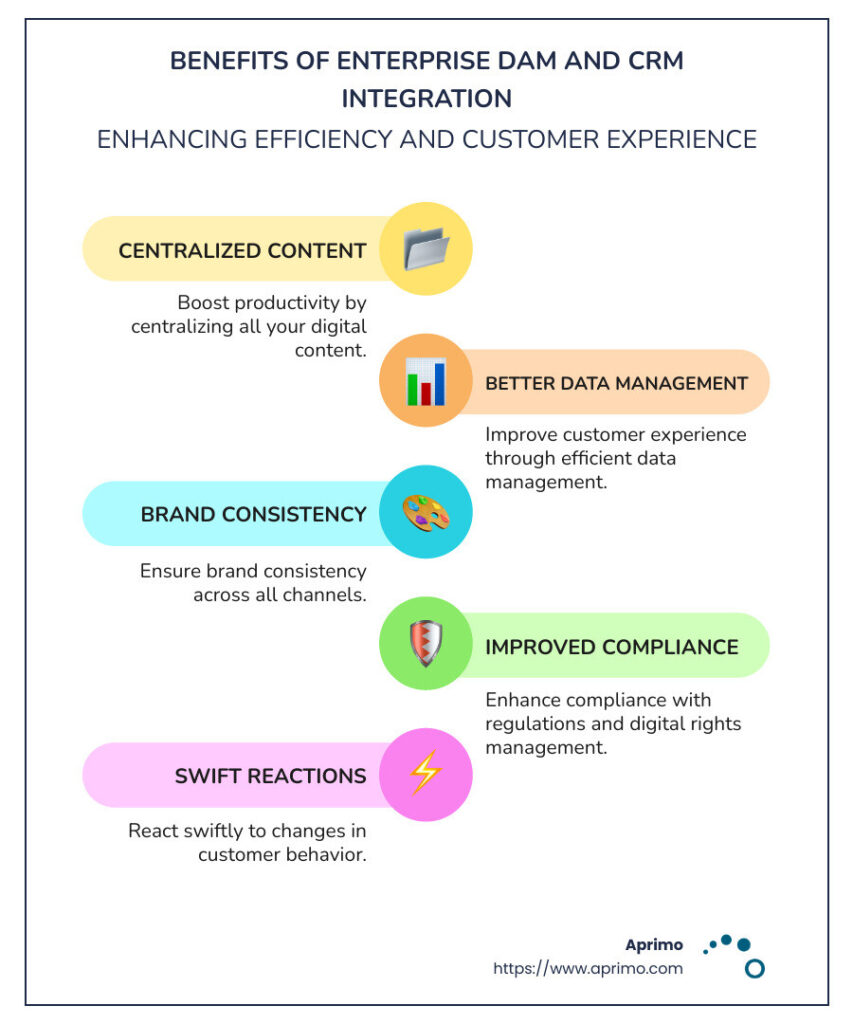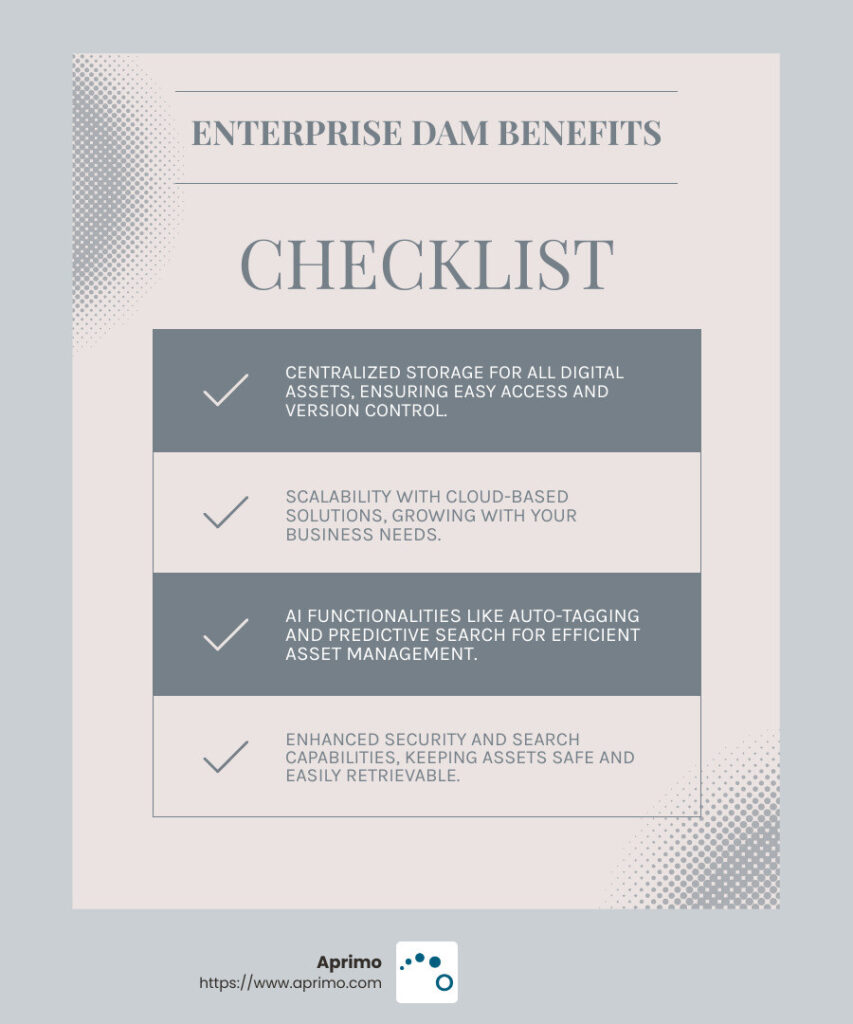Integrating digital asset management (DAM) and customer relationship management (CRM) systems offers businesses a powerful combination to enhance operational efficiency. A DAM system organizes and centralizes a company’s digital assets, while a CRM focuses on managing customer interactions and data.
When integrated, enterprise DAM and CRM allow businesses to easily access customer-specific content, streamline marketing campaigns, and provide personalized experiences. This leads to faster content delivery, improved collaboration across teams, and more effective customer engagement. Together, DAM and CRM create a unified ecosystem that not only saves time but also drives revenue by enabling seamless, targeted communication.
Enterprise DAM and CRM: a Hybrid System for Forward-Thinking Enterprises
Businesses generate vast amounts of digital content daily, from product photos and videos to marketing materials. As the volume of this content grows, so does the need for efficient management systems. Enterprise DAM systems help manage these assets while CRM systems focus on customer interactions and data.
The integration of these two powerful tools, often referred to as enterprise DAM and CRM, brings unparalleled efficiency. Without proper management, businesses can struggle with slow content creation, compliance issues, and inefficient asset use. Integrating DAM and CRM creates a single source of truth, improving workflow and enabling better decision-making.
This synergy streamlines operations and helps businesses react swiftly to changes in customer behavior, leading to improved marketing and sales outcomes.

What is DAM?
DAM systems are essential for modern businesses that handle large volumes of digital content. These systems offer a centralized storage solution for rich media assets like images, videos, and documents. By organizing these assets with metadata, DAM makes them easily searchable and reusable.
Benefits of DAM
Centralized Storage and Rich Media Management
Centralized storage and rich media management are critical components of an efficient digital asset management strategy.
Centralized storage consolidates all digital assets into a single, easily accessible repository. This organization simplifies access and ensures that teams across different departments can collaborate seamlessly, using the most up-to-date and approved versions of assets.
Rich media management refers to the specific handling of high-quality multimedia files, which require optimized storage solutions to support large file sizes, while also maintaining quick retrieval speeds. Together, these features streamline workflows, enhance content discoverability through metadata and tagging, and reduce duplication.
Scalability and Cloud-Based Solutions
Modern DAM systems are cloud-based, meaning they can scale with your business. As your company grows and generates more digital content, the DAM system can expand to accommodate these assets. This scalability is crucial for businesses of all sizes, from startups to large enterprises.
AI Functionalities and Automated Workflows
AI digital asset management features, like auto-tagging and predictive search, make it easier to manage large volumes of assets. Automated workflows can handle repetitive tasks, such as converting file formats or tagging images, freeing up your team to focus on creative work. In addition, automation for approvals and asset updates speeds up project timelines, ensuring assets move quickly from creation to distribution.
Efficiency and Collaboration
DAM systems improve efficiency and collaboration by centralizing digital assets and automating repetitive tasks. Teams can easily find, access, and share the most up-to-date assets through a single platform, reducing the time spent searching across different tools or file systems.
Collaboration is enhanced through version control and real-time sharing capabilities, which allow cross-functional teams to work on the same assets simultaneously without confusion over different versions. This streamlined communication and asset management enable teams to produce content faster, maintain brand consistency, and reduce the risk of errors.
Brand Consistency and Cost Reduction
Maintaining brand consistency is easier with a digital asset management system. All team members can access approved brand assets, ensuring that the same logos, colors, and fonts are used across all marketing materials. This consistency strengthens the brand and reduces costs by minimizing the need for rework and corrections.
Security and Search Capabilities
Security is a top priority for DAM systems. They offer robust access controls to ensure that only authorized personnel can access sensitive assets. Advanced search capabilities make it easy to find specific assets using various metadata tags, categories, and keywords.

What is CRM?
CRM systems help businesses manage and analyze customer interactions throughout the customer lifecycle. They enable companies to streamline processes, improve customer relationships, and increase profitability.
Benefits of CRM
Customer Data Management
CRM systems centralize all customer-related data, making it easier to access and manage. This data includes contact information, purchase history, and customer preferences. With all this information in one place, businesses can better understand their customers and tailor their services accordingly.
Sales Automation
One of the key features of CRM systems is sales automation. This includes tools to manage leads, track sales opportunities, and automate follow-ups. Sales teams can focus more on selling and less on administrative tasks, leading to increased productivity and higher sales.
Marketing Automation
CRM systems also support marketing automation. They can automate email campaigns, segment audiences, and track the performance of marketing efforts.
Customer Service
CRM systems provide tools to manage customer inquiries, track service requests, and ensure timely responses. This leads to better customer satisfaction and loyalty.
Analytics and Data-Driven Decisions
CRM systems come with robust analytics capabilities. They can generate reports on sales performance, customer behavior, and marketing effectiveness. These insights help businesses make data-driven decisions to improve their strategies and operations.
Sales Tracking
Sales tracking provides real-time updates on sales activities, helping managers monitor progress and identify areas for improvement. This ensures that sales teams are always on track to meet their targets.
Marketing Campaigns
CRM systems make it easy to plan, execute, and track marketing campaigns. They offer tools for segmenting audiences, automating email sends, and measuring campaign performance.
Comparing Enterprise DAM and CRM Features
Integration Capabilities
Enterprise DAM and CRM systems are powerful on their own, but their true potential is unleashed when integrated. This integration allows for seamless data flow between managing digital assets and customer interactions.
When enterprise DAM and CRM systems are integrated, you can link digital assets directly to customer profiles. For instance, a product photo in your DAM can be connected to customer purchase records in your CRM.
Seamless integration with tools like CMS, PIM, design tools, and social media platforms improves workflow automation. Imagine a scenario where a marketing team uses a DAM to store all campaign assets. These assets can be automatically tagged and linked with CRM data, ensuring that every customer interaction is backed by relevant content. This streamlines marketing efforts and ensures brand consistency.
Automation and AI
Both enterprise DAM and CRM systems leverage AI-powered features to improve efficiency and accuracy. In a DAM system, AI can automate tagging and categorization of assets, making it easier to find the right content quickly.
CRM systems use AI for predictive analytics and automated workflows. They can predict customer behavior, automate follow-ups, and personalize interactions. By integrating DAM and CRM, you can automate content creation and distribution based on customer data. For example, if a customer shows interest in a product, the system can automatically send them relevant videos or guides stored in the DAM.
Security and Compliance
Data security is crucial for both enterprise DAM and CRM systems. They must ensure that digital assets and customer data are protected from unauthorized access. DAM systems offer features like digital rights management (DRM) to monitor asset usage and compliance with licenses. For instance, DAM systems can track which promotional videos are clicked on the most, helping marketers identify successful content while ensuring legal compliance.
CRM systems provide access control to manage who can view and edit customer data. When integrated, these systems can offer a unified approach to regulatory compliance. For example, GDPR-compliant rights management in DAM systems ensures that all digital assets meet regulatory standards, while CRM systems manage customer consent and data privacy.
Key Considerations for Integrating DAM and CRM
When integrating enterprise DAM and CRM systems, several key considerations must be addressed to ensure a seamless and effective integration:
Data Synchronization: It’s important to ensure that both systems can communicate efficiently to sync data, such as customer information and digital assets. A real-time or near-real-time sync ensures that assets are always up-to-date and relevant for specific customer interactions.
Interoperability: The DAM and CRM systems need to be compatible and support integration through APIs or middleware. This ensures that both systems can exchange information smoothly without requiring manual workarounds.
User Access and Permissions: Both systems often involve multiple departments, so access controls must be well-defined. Role-based access ensures that the right users can view or edit content and customer data without risking unauthorized access or data breaches.
Metadata Alignment: Integrating DAM and CRM requires standardized metadata to ensure that assets are tagged and categorized in a way that matches customer data. This alignment enables personalized marketing campaigns and customer-specific content delivery.
Workflow Integration: Consider how workflows from both systems will intermingle. For instance, DAM workflows for asset approval need to align with CRM processes for managing customer interactions, campaigns, or sales cycles. Seamless workflow integration prevents bottlenecks and enhances collaboration.
Scalability and Performance: The integration must support scalability to handle large volumes of assets and customer data, especially as the organization grows. Both systems should be able to perform optimally without slowing down as more assets and customer records are added.
Compliance and Security: When integrating DAM with CRM, both systems must comply with relevant regulations (like GDPR or CCPA) and maintain a high level of data security. This includes managing permissions, encryption, and secure sharing protocols to protect sensitive customer and asset data.
User Training and Adoption: Teams from marketing, sales, and content creation must be trained on how to use the integrated system effectively. A user-friendly interface and proper training ensure high adoption rates to maximize the benefits of the integration.
By carefully considering these factors, organizations can create a powerful, unified platform that enhances efficiency, streamlines collaboration, and improves customer engagement across teams.
Use Cases for DAM and CRM Integration
Personalized Customer Experiences: By integrating DAM with CRM, businesses can quickly deliver personalized content based on customer profiles, behavior, and preferences stored in the CRM. For example, a sales team can access relevant marketing materials that align with a specific customer segment or individual, leading to more personalized and targeted marketing campaigns.
Sales Enablement: Sales teams can use CRM to identify customer needs, and the integration with DAM enables them to pull up the right digital assets (like case studies, brochures, or product videos) instantly. This ensures they always have the most up-to-date and relevant content at their fingertips, helping them close deals more efficiently.
Improved Campaign Management: Marketing teams can use CRM data to segment audiences and then leverage DAM to distribute the right assets across email campaigns, social media, or other marketing channels. The integration allows for the automated distribution of content based on customer journey stages, improving engagement and conversions.
Content Localization and Customization: As customer data flows from the CRM, marketers can pull assets from the DAM and tailor them to different languages, regions, or customer preferences, ensuring that content is culturally and contextually appropriate for each audience.
Efficient Asset Usage Tracking: Businesses can track which assets are most effective in engaging customers. For example, the CRM can record how often a particular asset is used in sales interactions or marketing campaigns, providing insights into asset performance and helping optimize content strategies.
Brand Consistency: The integration ensures that teams across departments are using the same approved assets from the DAM, all while drawing on accurate customer data from the CRM. This promotes brand consistency across marketing materials, sales pitches, and customer communications, ensuring a cohesive brand experience.
Customer Support and Training: Customer service teams can use the CRM to identify customer pain points and pull relevant support documents, FAQs, or training videos from the DAM. This allows them to provide faster, more accurate responses, improving customer satisfaction and retention.
Maximize Business Efficiency Through the Power of Integrating DAM and CRM Systems
Integrating enterprise DAM and CRM systems is a game-changer for businesses aiming to streamline operations and improve customer experiences.
When integrated, DAM and CRM systems create a seamless workflow that connects content management with customer interactions. This integration leads to centralized access, improved personalization, streamlined workflows, and improved analytics.
Aprimo stands out in the DAM industry with its AI-powered content operations platform. Our solution accelerates content creation, improves asset findability, automates asset management, and ensures brand governance. These features enable businesses to efficiently manage their digital assets while maintaining a consistent brand identity.
The integration of enterprise DAM and CRM systems is not just a trend but a necessity for businesses aiming to improve efficiency and customer satisfaction. By leveraging the strengths of both systems, enterprises can deliver personalized and consistent customer experiences, make data-driven decisions, and stay ahead in a competitive market.
At Aprimo, we are committed to helping businesses steer this integration with our advanced DAM solutions. To learn more about how Aprimo can help your company, book a demo today.


